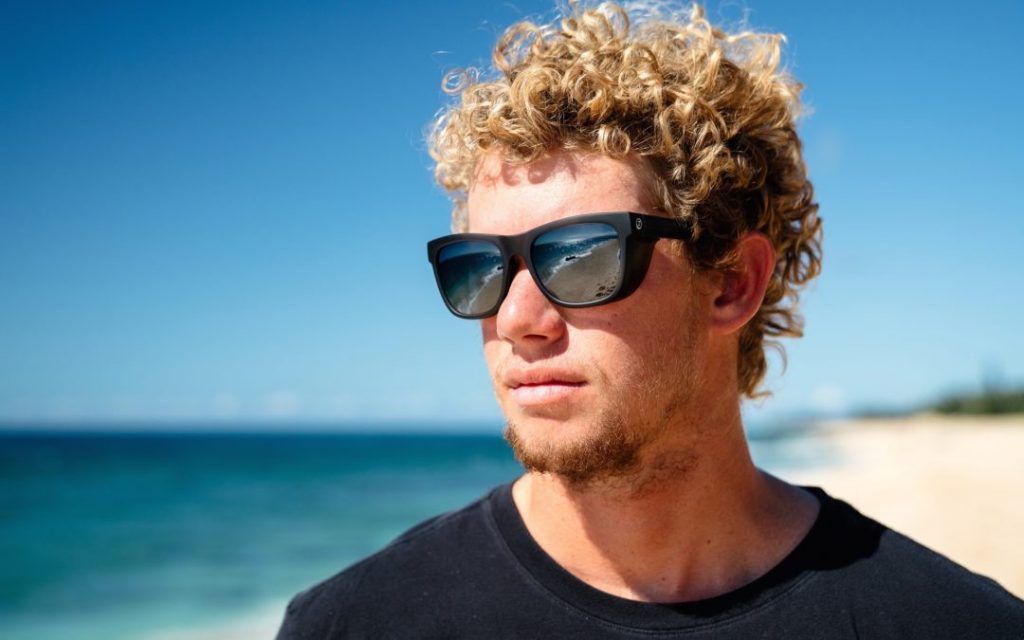Choosing the perfect pair of sunglasses can be an overwhelming process for many people. There are so many different brands, styles, shapes, and colors to choose from that it’s hard not to get overwhelmed. This guide will walk you through all of the things that you need to consider when choosing your new pair of shades. We’ll go over styles, shapes, materials, and more.
At the end of this guide, you’ll understand all there is to know about choosing sunglasses. And don’t worry – we won’t make things more difficult than they need to be. We will keep it simple and straightforward. Let’s get started with learning how to choose sunglasses for women or men:

Table of Contents
Types of Sunglasses
Sunglasses come in a variety of styles, colors, and shapes. You can get them to match any outfit or style that you might have. For example:
Sports Sunglasses – These are the most common type of sunglasses out there for people who like to spend time outdoors playing sports such as tennis, golfing (and other games), or even going on a run.
Glacier Sunglasses – Glaciers are also known as ski sunglasses. They come with a double lens that is curved to fit your face, and they’re meant to protect you from the harsh glare of the sun.
Fashion Sunglasses – These sunglasses are usually made out of plastic or metal and have cool-looking designs, shapes, colors, etc. so that the wearer can use them as part of an outfit’s overall look.

Sunglass Lens Types
There are three main kinds of sunglass lenses: polarized, photochromic, and mirrored.
- Polarized Lens – These lenses reduce the glare that bounces off of flat surfaces such as water and roads. They can also help to protect your eyes from UV rays, too. Many people prefer polarized sunglasses because they work so well – especially when you’re outside enjoying nature or playing sports in the sun!
- Photochromic Lens – These are darker than regular sunglass lenses, and they adapt to the lighting that is around you. For example, sunlight makes them darker while shaded areas make them lighter.
- Mirrored Lens – These are mostly used for fashion purposes, but they can also help to reduce the glare that bounces off of them.

Light Transmission
Light transmission is how much light passes through your sunglasses. The higher the percentage, the more you’ll be able to see clearly when wearing them.
- 0–19% VLT: Ideal for Bright, Sunny Conditions
- 20–39% VLT: Good for all-purpose use
- 40-59%: Good for Low-light Conditions such as sunrise or sunset
- 60+% VLT: Ideal for Nighttime use

Lens Color
Just like the lens types, there are many different colors of lenses available. They can be used to match your outfit, your style, or whatever you might feel like wearing.
- Yellow – This is the most popular lens color out there because it reduces glare and enhances contrast. They’re very popular with golfers and hunters because they help them to see more easily.
- Green – This lens color is also popular because it reduces glare, but they provide a more natural color than yellow lenses might.
- Brown – This lens color does a great job of blocking out the sun’s harmful rays. They’re best for people who don’t spend much time outside in the direct sunlight.
- Purple – These lenses are mostly used for style purposes, but they’re great at reducing glare and enhancing contrast.
- Dark Gray – This lens color provides the best all-purpose protection out of any other color. It’s also great for people who have sensitive eyes to light because it doesn’t change the color of their eyes as much as other colors might.

Light Conditions
Different lighting conditions require different types and levels of protection from sunglass lenses. Here are some examples:
- Bright Sunlight – Sunglasses with polarized lenses work best for bright sunlight conditions because they reduce the glare bouncing off of flat surfaces.
- Low-Light Conditions – Sunglasses with photochromic lenses are best for low-light conditions because they adapt to the lighting around them.
- Direct Sunlight – Sunglasses with mirrored lenses are best for direct sunlight because they reduce the glare that bounces off of them.
- Intense Sunlight – Sunglasses with mirrored lenses are best for intense sunlight because they reduce the glare that bounces off of them.

Sunglass Lens Coatings
To protect your eyes, even more, you can purchase lenses with coatings on them. Here are some of the most common ones:
- Scratch-resistant coatings – These are great for protecting your expensive sunglasses from getting damaged.
- Anti-reflective coating – This reduces the amount of light that is reflected off of your lenses. This is very helpful when you’re outside in the sunlight because it helps to keep your eyes from straining so much.
- UV-resistant coatings – Sunglass lenses that have this type of coating protect your eyes from harmful UV rays. If you’re outside a lot and you don’t want to wear sunglasses, make sure that the lenses block 100% of both UVA and UVB light.
- Anti-fog coating – This prevents your lenses from fogging up when you’re outside on a humid day.
UV-A and UV-B Protection
We mentioned that sunglasses can protect your eyes from UV rays, but what exactly is a UV ray? Ultraviolet light comes in two types:
- UV-A – These are the rays that cause your skin to tan, and they can also damage your eyes.
- UV-B – These are shorter waves that can cause sunburn on your skin as well as damage to your retinas.
Note: The type of sunglasses you choose should have 100% protection from both UV-A and UV-B rays

Sunglass Lens Materials
Choosing the right sunglasses lens material is just as important as choosing the type and color of lenses you want. Here are some common sunglass materials:
- Glass – These have a very natural feel because they’re so clear, but on top of that, they also provide 100% UV protection without distorting colors or causing any problems with clarity.
- Plastic – This material is a lot more affordable than glass, but it can distort colors and not provide as much clarity.
- Polycarbonate – These lenses are easily the most popular because they’re lighter weight while still being very clear and durable. On top of that, these types of sunglasses are also very affordable.
- CR-39 – These lenses are a lot more affordable than glass and plastic, but they don’t offer 100% protection from UV rays.
- Acrylic – This material is lightweight, affordable, and doesn’t distort colors, but it’s not as durable as the other sunglass materials.
- Trivex – These are the lightest materials available on the market today, but they do distort colors a little bit more than other types of lenses.

Sunglass Frame Materials
Just like with sunglass lens materials, we always recommend choosing a pair of sunglasses that are made from the most durable material. Here are some common sunglass frame materials:
- Plastic – These are the most common types of sunglasses frames because they’re affordable and very durable.
- Titanium – This material is very lightweight, but it’s also strong and durable.
- Aluminum – Although this material isn’t as popular as plastic or titanium, it’s still lightweight, inexpensive, and very durable.
- Nylon – This material is very popular in sports sunglasses because it’s lightweight, flexible, and durable.
- Acetate – This material is very strong and durable, but it can warp if it gets bent too much.
- Castor-based polymer – This is a lightweight material that’s great for sports sunglasses because it can flex without breaking.
- Carbon fiber – This is another lightweight material that’s great for sports sunglasses because it’s very strong and durable.

Cost and Quality of Sunglasses
When you’re shopping for sunglasses, the quality of what you buy is always determined by how much money you spend on them. That being said, we always recommend that you don’t go with the cheapest pair of sunglasses that you can find because it’s just not worth saving a little bit of money.
If your eyesight is really bad, you should invest in a higher-quality pair of sunglasses. If your eyesight isn’t so bad and you just wear glasses occasionally, you can probably get away with spending less on sunglasses.
If your eyesight is somewhere in the middle, we recommend choosing a pair of glasses that’s in the mid-range when it comes to price.
As we mentioned earlier, your sunglasses should be comfortable enough for you to wear all day long, so if you find a pair of sunglasses that’s extremely lightweight and durable but it’s also expensive, we recommend buying them because they’ll probably last you a long time.

Sunglass Fit Tips
A good fit is essential for a pair of sunglasses to protect your eyes properly, and it can even help you look better. Here are some things you should keep in mind when you’re shopping for sunglasses:
Sunglasses typically come with either a plastic or nylon bridge. Make sure that the bridge of the sunglasses is compatible with your nose because it’s annoying when you’re trying to wear them and they keep slipping off.
If you don’t like the way plastic or nylon feel, look for sunglasses with metal bridges.
Make sure you try on both glasses and see which ones fit better before you make your purchase.
Also, try to shop for sunglasses at the end of the day because that’s when people tend to have swollen eyelids.
You can also ask for a demo to try on sunglasses with your eye cream or makeup, just in case, it makes any difference.

What to Avoid
When you’re shopping for new sunglasses, there are a lot of things to watch out for. Here’s what we recommend avoiding when you’re shopping for new sunglasses:
- Avoid buying cheap sunglasses because they can’t protect your eyes from UV rays.
- Don’t forget that the color of the lenses can make a big difference when it comes to protecting your eyes. Make sure you choose sunglasses with 100% protection from UV rays, so you can enjoy being outside without worrying.
- Don’t forget to read the return policy before making your purchase because sunglasses are an item that people typically keep for a long time.
- Don’t buy sunglasses without trying them on first because they might not fit your face or look right with your outfit.
- Don’t buy sunglasses that are too tight or loose because it can be dangerous for your eyes.
- It’s also a good idea to avoid buying sunglasses that don’t fit your face because they can slip and slide when you’re trying to wear them.
- You should also avoid buying fake or knockoff sunglasses because it’s illegal to do so. Not only is it illegal, but you can seriously damage your eyes.

How To Clean Your Sunglasses
When you’re buying sunglasses, it’s important to keep in mind that you’ll have to take care of them. Here are some tips for how to properly clean your sunglasses:
- Make sure you only use glass cleaner or water to clean your glasses. Never use paper towels, napkins, tissues, or anything else because it can scratch your lenses.
- When you’re buying sunglasses, make sure you get a soft cloth for cleaning them so there’s no risk of scratching.
- If you’re planning to clean your sunglasses with water, make sure the lenses are dry before you put them on because they can slip and slide.
- When you’re cleaning your sunglasses, make sure to wipe them with both sides of the cloth because they can have dirt on both sides.

FAQs
Q.How often should I replace my sunglasses?
A.It’s a good idea to get new glasses every two years, but you can keep them longer if you take good care of them.
Q.What should I do if my sunglasses aren’t protecting me properly?
A.It’s a good idea to replace your sunglasses if you notice any scratches on your lenses. Scratches can block some of the UV rays, which is bad news for your eyes.
Q.How can I make sure my glasses are protecting me properly?
A.You should bring your sunglasses with you when you go for an eye exam. Your eye doctor can tell you if your glasses are protecting your eyes properly or not, and they might be able to give you a prescription if you need one.
Q.Do polarized sunglasses protect your eyes better?
A.Yes, polarized lenses are much better for protecting your eyes. They cut down on the glare and make it easier for your eyes to focus.
Q.What can I do if my sunglasses keep slipping off my face?
A.You can buy sunglasses that have adjustable nose pads, or you could try using a different pair of glasses. If your glasses keep falling off your face, it can be dangerous for you to wear them.
Q.Do sunglasses help my eyes?
A.Yes, sunglasses can help your eyes because they protect them from harmful UV rays. Sunglasses are the first line of defense against sun damage, so it’s important to make sure you’re wearing the right kind.
Q.What are polarized sunglasses?
A.Polarized sunglasses are made with special lenses that block out the sun’s glare and reduce eye strain. If you work outside, or if you spend a lot of time in the car, polarized sunglasses can be very helpful for protecting your eyes.
Q.What are lenses made of?
A.Lenses can be made out of plastic or glass, and they come in different strengths depending on what you need. Some people get reading glasses, which have very weak lenses, while other people wear sunglasses with extra-thick lenses to protect their eyes.









